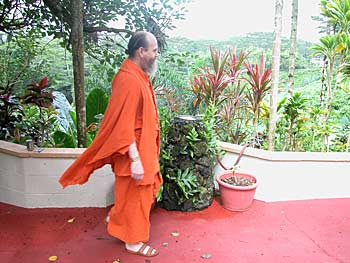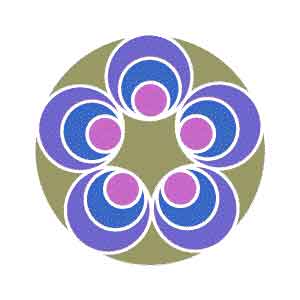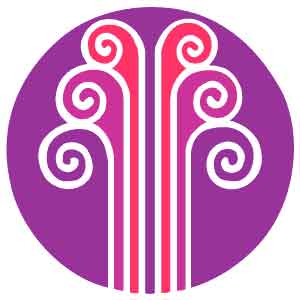Blog Archives

Here is a wonderful quote from the Master Course:
“The Natha Sampradaya has revealed the search for the innermost divine Self, balanced by temple worship, fueled by kundalini yoga, charted by monistic theism, illumined by a potent guru-shishya system, guided by soul-stirring scriptures and awakened by sadhana and tapas.’
Our Beloved and Revered Satguru Sivaya Subramuniyaswami
Attained Maha Samadhi on November 12th, 2001
Click to read for Details.
Mystic Mouse Coloring Book Now available
Today’s sample page. —– Click here to get your copy today!

Bodhinatha arrives tomorrow on Kauai around 11 AM in the morning after a very long non-stop trip from Singapore. We will bring your more news from his stay in Malaysia and Singapore after the team returns. Meanwhile, now is a good time to start thinking about next year’s innersearch. Why don’t you join Bodhinatha in India! Click here for information.
Cybertalk: Bodhinatha continues with highlights from a talk he is preparing for Mauritius on God Siva, talking about the nature of God Siva. He is the supreme parent, and each of us is His child. God Siva loves and blesses us no matter what we do. Bodhinatha also talks here about what we can do to get closer to God.
Cybertalk Ends”
For more information about listening to Gurudeva’s talks online and to hear them in other formats, click here.
And click here for an Index to All Past CyberTalks.
Study Gurudeva’s teachings
every day. Visit the Master Course site!
Bodhinatha will be happy to hold “Prasnottara Satsang” — “Questions and Answers” over the telephone with any Hindu religious societies, Hindu youth groups, Radio talk show hosts etc. All you need is a phone with a speaker and an enthusiastic audience. Arrangements may be made in advance by sending email to Sadhaka Mahadevan
If you are experiencing any problems listening to the audio, please to go our Audio FAQ page for sound geeks and follow the directions there.
 |
|
|
|
|
 |
||||
Our phase opened today with a profound homa in the early morning hours. In the absence of our usual homa priest Sadhaka Tyaganatha who is with Bodhinatha on mission, Sannyasin Saravanathaswami presided today, while the swamis chanted Sri Rudram twice through.
The performance of japa by the whole group is counted off on a mala as everyone chants together: “Om Ham Haum Sivaya, Svaha!”
We were honored today with a visit from world renowned hatha yogi, Sri Pattibhi Jois and a small group of dedicated students who are with him here on Kauai. A proponent of “Ashtanga yoga” Jois is now 88 years of age and still teaching. He brought forward to the west the system of “vinyasa yoga” comprising a series of vigorous and demanding postures combined with carefully regulated deep breathly. He is also a deeply religious Hindu and a sweet and wonderful soul.
“Guruji” or “Yogiji” as he is affectionately called by his disciples, ascends to our temple site. You can read more about him in Hinduism Today at this page:
http://www.hinduismtoday.com/2001/1-2/2001-1-26.html
Our silpis are in the middle of course number thirteen.
The temple really feels way up there now!
Everyone was fascinated as the silpis made some minute adjustments in the position of these giant stones.
Paramacharya Palaniswami hosts the group at our publications building and explains to the group about the public service of Hinduism Today.
Bright and healthy souls are the result of years of consisent dedicated hatha yoga practice!
This is a digital post card from the Katirs home to Sivajnani Nagappan in Malaysia. Amala and the two children say “Hi Daddy” from Kauai to Malaysia. Little Tuhina and Yajatadeva are doing just fine!

In Malaysia at the officlal launchng of Living with Siva, Bodhinatha signed hundreds of books. Outside the hall our team there did kolams of the various logos we use. Today we share these with you and what they mean:
~~~~~~~~~~~~~
Here is the logo for Saiva Siddhanta Church:
This logo represents a contemporary tripundra, the three holy ash lines of Vibhuti which mark the forehead of devout Saivites, carrying a reminder of the three-fold bonds of worldliness, anava, karma and maya. The saffron-colored sandalwood circle holds the red dot of kumkum, bindu or pottu, mystically representing the third eye and serving as a reminder to all seekers to cultivate their inner vision and to see the world as divine, which is what it appears to be through the mind’s eye, and not just to be aware of the gross material world shown by the physical eyes. With that mystical vision we perceive and understand the inner workings of life, and our own soul’s divinity.

San Marga: The five circles are five potencies of Lord Siva sometimes depicted as the five-faced Sadasivamurthi: Isana (the power of revealment), Tatpurusha (the power of obscuration), Sadyojata (the power of creation), Vamadeva (the power of preservation) and Agora (the power of reabsorbtion). Within each of these is a smaller circle, representing the all-pervasive Satchidananda, and within this another circle representing Parasivam beyond time, form and space. In Iraivan Temple only Siva is worshipped, for in all the universe only Siva exists. Also, seen from above, the five circles are interpreted as five shishyas in meditation, backs together, all seeking God Realization together, in sangam, in harmonious and yogic cooperation.

Himalayan Academy: The three tear-shaped elements of the circle represent many things in Saiva Siddhanta. First, they are the three worlds, physical, astral and causal. Secondly, they are God, soul and world, pati, pasu and pasam, which taken together represent all there is and will ever be. The circle represents Siva, the wholeness and perfection which encompasses the parts.

Hinduism Today: Here we have three primary meanings all woven into a single design. First, we have two sets of quotation marks in a circle, for the mission Gurudeva gave to the magazine was to uplift the Hindu world and tie it together with informative articles, to educate through the sharing of knowledge, to guide people and institutions in the ways of dharma and the application of Hindu wisdom to modern issues and events, and all this happens through words. Second, we have the rollers of a printing press, turning and turning, printing tens of thousands of pages, for the magazine is given birth at the printing press. Finally, it all forms a contemporary swastika, the auspicious symbol which means “all is well” and represents the sun, the source of light and life, as Hinduism Today is a source of inspiration and illumination to the world.

Innersearch: Our travel study programs move by land, sea and air, these three represented here within the circle that is the globe, for we move about the earth, going to many nations on all continents. It is also a symbol of the teachings of our beloved Gurudeva who founded Innersearch and used it to introduce hundreds of aspirants to his teachings of the mind and of its three aspects: instinctive, intellectual and spiritual. Each of these is part of the fullness (the circle) of being human.

Hindu Heritage Endowment: (HHE) The contemporary design is a fountain flooding life-giving energies into the world, waters to quench the spiritual thirst of all of humanity. It represents HHE’s effort to bring life to Hinduism, and life-giving abundance to Hindu institutions around the globe (which is the circle in this case). There are three sets of fountain, representing three streams of abundance: physical is the smallest, mental/emotional is the middle one, and spiritual/divine is the largest.
| FULL INDEX OF 650+ CYBERTALKS
 |
|
Study Gurudeva’s teachings.
|
transcription begins
Date: July_28_2002
Title: Guru Purnima Talk on Karma Management Day 1 Part 2
Category: Karma
Duration: 10 min., 36 seconds
Date Given: July 18, 2002
Given by: Bodhinatha
So, misconception. After I give the misconception, I will ask you to raise your hands and let me know how many of you have heard this misconception at least once before. The misconception goes something like this.
“Nothing but bad things are happening to me. It is my karma. There is nothing I can do about it at all. Even if I try to change my karma and make things go better, I can’t do it. It is hopeless, I give up. What can I do?”
How many of you have ever heard someone explain karma like that? Quite a few, okay!
This explanation, in fact, is responsible for this whole presentation. There was a young man in Maryland whose family is affiliated with the Murugan Temple in Maryland. They were calling in for a Satsang, the Master Course question and answer session over the phone. At one point, this young man made that statement and it got me fired up. I said this is about the third time in two months that I have heard this. It keeps coming in, in different ways, the third time in two months this statement has come. Since then, there was a fourth time when we went back to Pennsylvania. Some young man stood up and said, “I don’t like the Law of Karma”, and said the same thing.
So, it is a common misconcept among younger people. People, say under the age of thirty, have this fatalistic idea about karma. “It is bringing bad things to me. It is hopeless. I have a destiny that is unchangeable. What is the use? Why even try? Hinduism just gives me no hope.”
Of course, as we all know from Gurudeva’s teachings, that is not a correct concept. It is a very flawed concept but it is still a common one. Why is it flawed? How is it flawed? It is flawed in two important ways.
The first is, it says you cannot change your karma, which is not correct. Gurudeva gives us a number of techniques for changing our karma and the name we use to describe that is ‘mitigate’, to lessen the effects of something. We will get into that at length because that is one of the most important principles of Effective Karma Management. How can I mitigate my karma? How can I change it? How can I reduce the negative impacts of it? So we can.
The second point, which should be self evident is, the Law of Karma governs our future. Right? It does not only govern our present. What we are doing now, is creating our future. Don’t we want to create a happy future? A problem free future? A future in which we have plenty of everything we want? A future in which our spiritual life is going well? We are not just talking about this life but next life, the life after. Don’t we want to create that if we can? Well, we can create that by applying the Law of Karma to the future. But, it is amazing that is not commonly thought about. We tend to think, “Oh, here I am in the present and this is all happening to me. It is my karma.” Instead think, “Here I am in the present creating my future by how I live now. I am going to create what I experience both in this life and in future lives.”
That shows us the two ways in which this common misconcept is seriously flawed.
We chose three correct concepts to present this morning. Each time we give a talk, we will choose a few concepts. We don’t want to overwhelm everyone with all the terminology at once. So we are just throwing a few out every day and a few effective principles every day.
Start with the obvious. What does the word karma mean? Just in case somebody does not know. Sometimes, we don’t start with the obvious, we keep going and we leave someone out. So we want to start with the obvious, which is karma means deed or action. That is what it means. The literal meaning of the word karma is deed or action. One of the most common uses of the term outside of just talking about karma as we were is in Karma Yoga. How many of you have heard of Karma Yoga? Karma Yoga is the path of union through action. Meaning, we are doing good deeds, we are being selfless, we are helping others. Through that path, we create good karma and become closer to God. So, it is a common use of karma, the phrase, Karma Yoga.
Second concept, karma as the Law of Karma. That is one way in which it is commonly used. The Law of Karma, what goes around comes around. That is the popular understanding of the Law of Karma, the law of action and reaction or the law of cause and effect, which is very simple. Whatever we send out to the world, the world sends back to us.
Gurudeva would always, when visiting temples, be generous. He would start ‘Building Fund’ drives, give the first hundred dollars. Well, he did it for a few reasons, one of which is, he is a very generous person. But, he was creating funds coming back to us. You cannot give anything away really, eventually it comes back to you.
That is an example of the Law of Karma. Being generous to others, others are generous to you in the future. Likewise, if we are stingy to others, we don’t share, we hoard. In the future, people will hoard from us. We will be without.
Whatever we send out comes back to us in the future. Not only our actions create karma but also our words and even our thoughts. So karma works at all levels. Even if we just think negative, terrible thoughts about certain people, that is hurting them. People are influenced by the thoughts about them. If we think positive thoughts about people, it makes them feel better. If we think negative, strong negative thoughts not just a passing one, but strong negative thoughts about other people, it hurts them. That will come back to us as well.
The third use of karma is one’s individual karma. The easiest way to think about that is, every action has a reward or a punishment that goes with it. It is like the Justice system. In the Justice system, if you do something wrong, eventually you get punished. But, it can take a long time because the Justice system moves very slowly. The courts are backed up, it could take years before your wrong action is finally punished. If you think the courts are slow, the Law of Karma is even slower. It can take lifetimes and that is the part we can’t really see.
When we are born into this life, we bring with us all the rewards and punishments from our past actions that have not yet manifested, that have not yet expressed themselves. We bring them with us, both good karma and bad karma. So, that is called an individual’s karma.
Sometimes we jump back and forth between the Law of Karma and one’s individual karma. We call both ‘karma’. It confuses people, which it should. We should have another terminology, but we don’t. We use karma to refer to both.
The idea is to distinguish between karma when we are talking about the Law of Karma and karma when we are talking about an individual’s karma, that they bring into this life.
transcription ends
|
MORE UPLIFTING THINGS |
Innersearch 2003-4 in India!
We just completed the July 17-23 Kauai Innersearch, 2002. Bodhinatha will lead the next Innersearch to India, between Dec 2003 and Jan 2004. We will visit Bangalore and the Iraivan Carving Village, and settle in the South in Tamil Nadu, Click on the above for details on what will be an inspiring journey to our holy land of Bharat! |
|

|
Check our children and youth section for new items for the young and young at heart! | |
|
1. SIGN OUR GUESTBOOK and receive a FREE GIFT |
||
| 2. Newest Book: LIVING WITH SIVA | ||
|
3. Visiting KAUAI’S HINDU MONASTERY |
||
|
4. Contribute to THANK YOU, GURUDEVA FUND |
||
From Our Gurus' Teachings
Archives are now available through 2001. Light colored days have no posts. 1998-2001 coming later.
